Hello, everyone. My name is Daichi, an expert providing the information on the radiation issues in an easy-to-understand manner.
As a continuous work from the previous article, today I would like to respond to the following questions:
– Evacuation areas were re-organized after their designation, but how have they changed with time?
– What are the evacuation areas after re-organization: ‘Difficult-to-Return Zones’, ‘Habitation Restricted Areas’ and ‘Preparation Areas for list of Evacuation Order’?
This article covers from the beginning of lift of evacuation order (January 2014) to the lift of all evacuation orders except for the Difficult-to-Return Zones (March 2020).
The following figures were mainly created based on the website of the Fukushima prefectural government (in Japanese).
If you would like to get more detail information, please visit this website or the websites of the national government as well.
Table of contents of this article
- Evacuation orders after the accident of the Fukushima Daiichi NPP (Vol. 2)
- Evacuation areas after their re-organization
- Difficult-to-Return Zones
- Habitation Restricted Areas
- Preparation Areas for Lift of Evacuation Order
- Conditions for list of evacuation order
- Changes of evacuation areas with time
- April 1, 2014
- October 1, 2014
- September 5, 2015
- June 12, 2016
- June 14, 2016
- July 12, 2016
- March 31, 2017
- April 1, 2017
- April 10, 2019
- March 10, 2020
- Summary
I have been involved with the radiation-relevant issues, like the policy on the decontamination activities and the management of the Interim Storage Facility, after the accident of the Fukushima Daiichi Nuclear Power Plant in 2011.
I received a doctorate in the field of radiation, while working in Fukushima.
Evacuation orders after the accident of the Fukushima Daiichi NPP (Vol. 2)
As aforementioned, the previous article covers changes over time from shortly after the accident to re-organization of evacuation areas.
After the re-organization, evacuation orders were in sequence lifted, in response to reduction of air dose etc., so let’s look together the history.
Evacuation areas after their re-organization
Before going into detail of lift of evacuation orders, the evacuation areas after their re-organization will be briefly explained in the following table.
| Exposure dose | Management of areas (ex.) | |
|---|---|---|
| Difficult-to-Return Zones | Possibly not less than 20mSv/y in 5 years More than 50mSv/y | - Thorough evacuation (e.g. Construction of barricade) - Temporary entry of residents is admitted, on the premise of implementation of screening, management of personal exposure dose etc. - Policy for decontamination and reconstruction of infrastructure will be considered, based on the results of demonstration projects |
| Habitation Restricted Areas | More than 20mSv/y | - Evacuation in principle - Temporary return (stay overnight is prohibited), through-traffic, entry for public purposes (e.g. Reconstruction of infrastructure, disaster prevention), are admitted |
| Preparation Areas for Lift of Evacuation Orders | Surely 20mSv/y or less | - Evacuation in principle - Temporary return (stay overnight is prohibited), through-traffic, entry for public purposes (e.g. Reconstruction of infrastructure, disaster prevention), are admitted - Resumption of manufacturing, agriculture is flexibly admitted - Screening during temporary entry is not necessary. |
Difficult-to-Return Zones
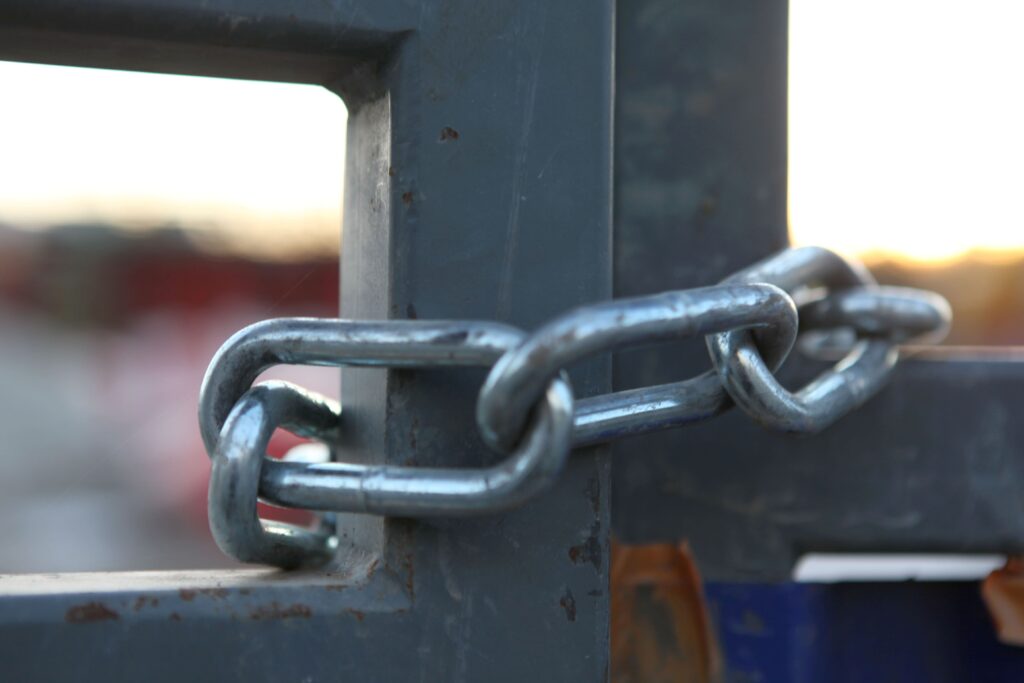
The Difficult-to-Return Zones are the areas, which are most severely impacted by radioactive materials released from the Fukushima Daiichi Nuclear Power Plant, and it includes Okuma Town and Futaba Town, where the Fukushima Daiichi Nuclear Power Plant is located, Tomioka Town, which is located in the south of Okuma Town, as well as Namie Town, Katsurao Village, Minamisoma City and Iitate Village, which are located in the northwest of the nuclear power plant.
Specifically, the areas is defined as the areas where cumulative exposure dose would not possibly be less than 20mSv/y in five years after re-organization of the evacuation areas, and also the cumulative exposure dose is more than 50mSv/y.
Except for the exceptional measures, in principle, in the areas, evacuation of people have been thoroughly implemented, for example, by setting up barricades.
At the time of re-organization of the evacuation areas, the designation of the Difficult-to-Return Zones was subjected to be fixed at least for 5 years(around 6 years from the accident)(Please visit this website for a reference (in Japanese)), and even this point of time (around 11 years after the accident), the evacuation orders of the Difficult-to-Return Zones have not been lifted, except for the limited areas in the vicinity of the Joban Line.
In the aim of lift of the evacuation order in 2022 and 2023, the Specified Reconstruction and Revitalization Bases are currently under construction (Please visit this website for a reference (in Japanese)).
Measures in the Difficult-to-Return Zones, including construction of the Specific Reconstruction and Revitalization Base, will be elaborated in another article.
Habitation Restricted Areas

The Habitation Restricted Areas are defined as the areas, where exposure dose would be more than 20mSv/y at this point of time.
It includes the areas of the municipalities, which were designated as the Deliberate Evacuation Areas before their re-organization, in the north or northwest of the Fukushima Daiichi Nuclear Power Plant like Iitate Village, Katsurao Village, Namie Town, Kawamata Town and Minamisoma City, as well as the municipalities in the vicinity or the southwest of the power plant, like Okuma Town, Tomioka Town and Kawauchi Village.
In this areas, in principle residents were forced to evacuate, but temporary return to their home (staying over night was prohibited), through-traffic and entry for public purposes (e.g. Reconstruction of infrastructure, disaster prevention), were admitted.
Preparation Areas for Lift of Evacuation Order
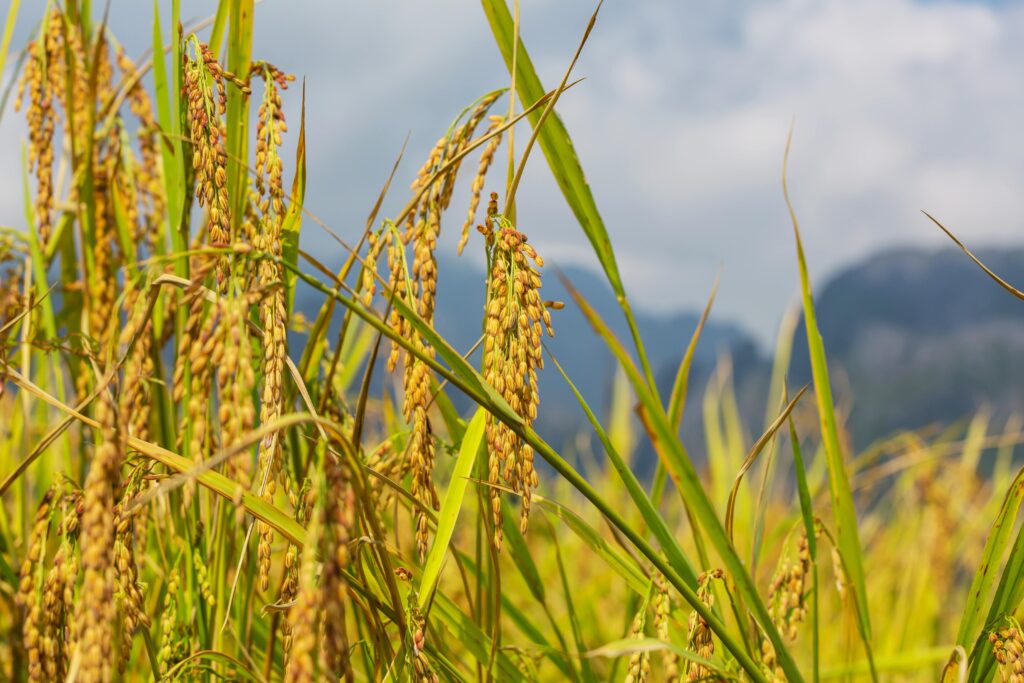
The Preparation Areas for Lift of Evacuation Order are defined as the areas, where at this point of time exposure dose is more than 20mSv/y, but it is surely going to be 20mSv/y or less, and includes all 11 municipalities where evacuation orders were declared after its re-organization.
In the Preparation Areas for Lift of Evacuation Order, in principle, residents were forced to evacuate, but as is the case with the Habitation Restricted Areas, temporary return to their home (staying over night was prohibited), through-traffic and entry for public purposes (e.g. Reconstruction of infrastructure, disaster prevention), were admitted.
And also resuming manufacturing and agriculture were flexibly admitted, and screening during temporary entry was not necessary.
Conditions for lift of evacuation order
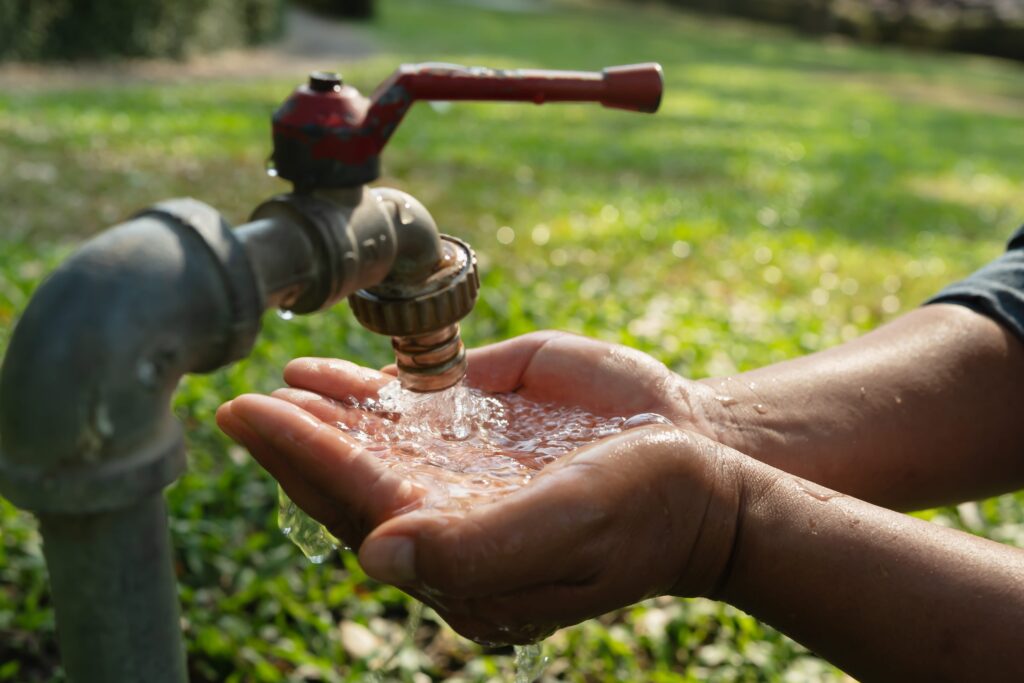
By the way, the following three conditions for lift of evacuation order are stipulated in this aforementioned document (in Japanese).
– Almost full recovery of infrastructures (e.g. electricity, gas, water, waste water treatment, major transportation, communications) and life-relevant services (e.g. medication, health care, post) which are essential for daily life.
– Sufficient progress of decontamination mainly in children-relevant environment.
– Sufficient discussion with the Fukushima Prefecture government, relevant municipalities and residents.
However, in December 2020, made a policy open to the public, that regarding the aforementioned the Specified Reconstruction and Revitalization Base, in case of utilizing lands without any habitation, the evacuation orders can be lifted, without meeting the second condition (i.e. sufficient progress of decontamination), taking account of intention of local stakeholders (please refer to this document (in Japanese)).
Changes of evacuation areas with time
Taking account of above-mentioned general description of re-organized evacuation areas, as well as conditions for lift of evacuation order, let’s look changes of the evacuation areas over time after April 2014.
April 1, 2014
On April 1, 2014, evacuation order in the part of Tamura City was lifted.
This was the first case for lift of evacuation order.
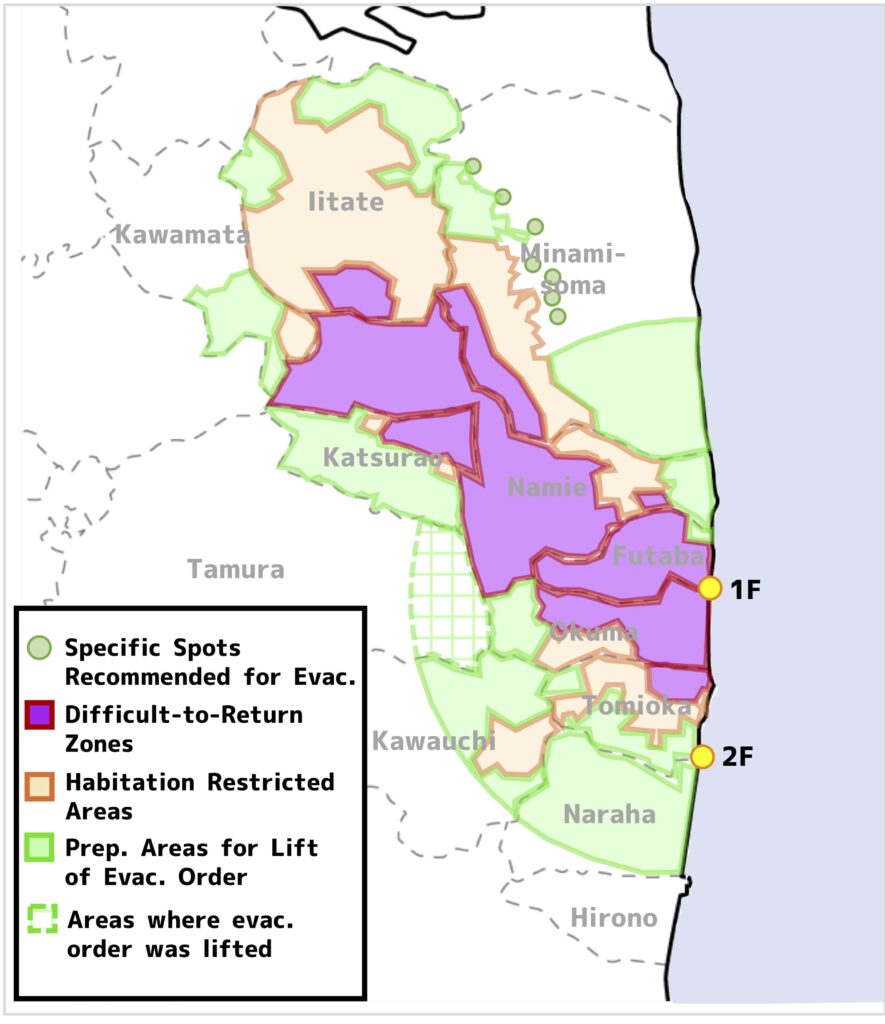
↑April 1, 2014
October 1, 2014
6 months later, on October 1, 2014, the Habitation Restricted Areas in Kawauchi Village was re-categorized into the Preparation Areas for Lift of Evacuation Order, and the evacuation order in the Preparation Areas for Lift of Evacuation Order was lifted.
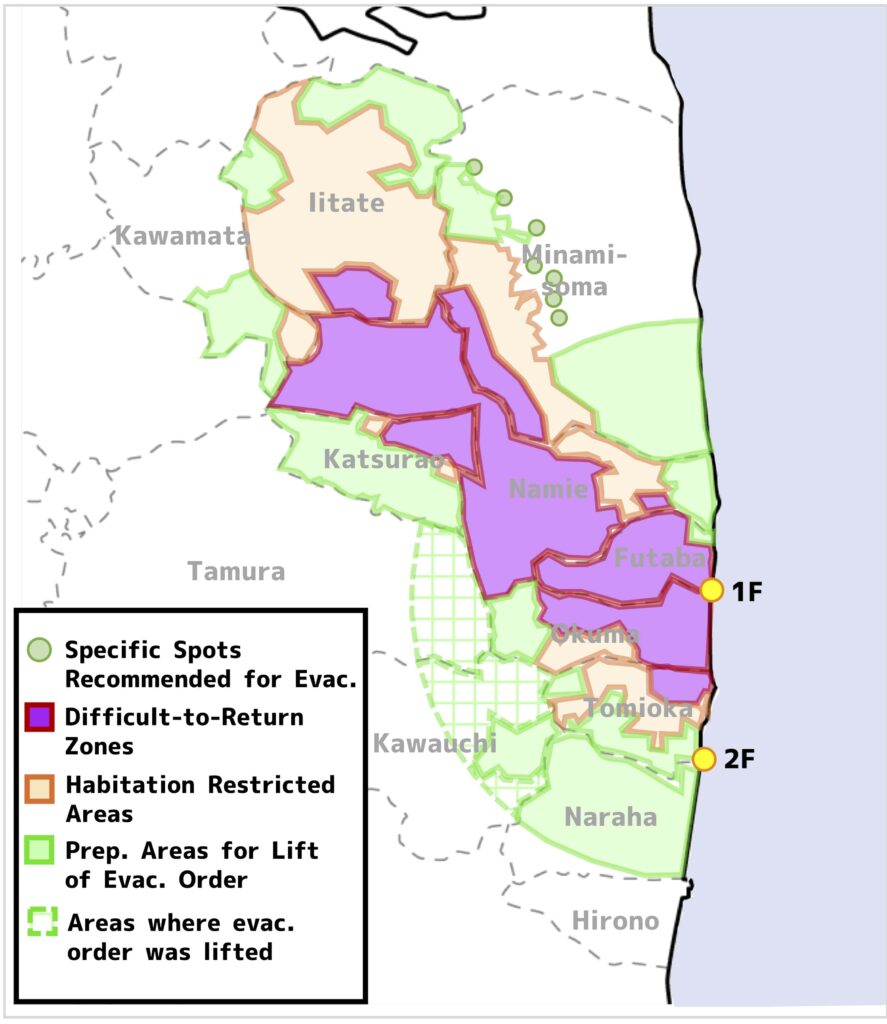
↑October 1, 2014
September 5, 2015
After the designation of the Specific Spots for Recommended for Evacuation was lifted in Minamisoma City in the end of 2014, the evacuation order in Naraha Town was lifted in September 2015.
Naraha Town is the second municipality, where evacuation order for whole municipality was lifted.
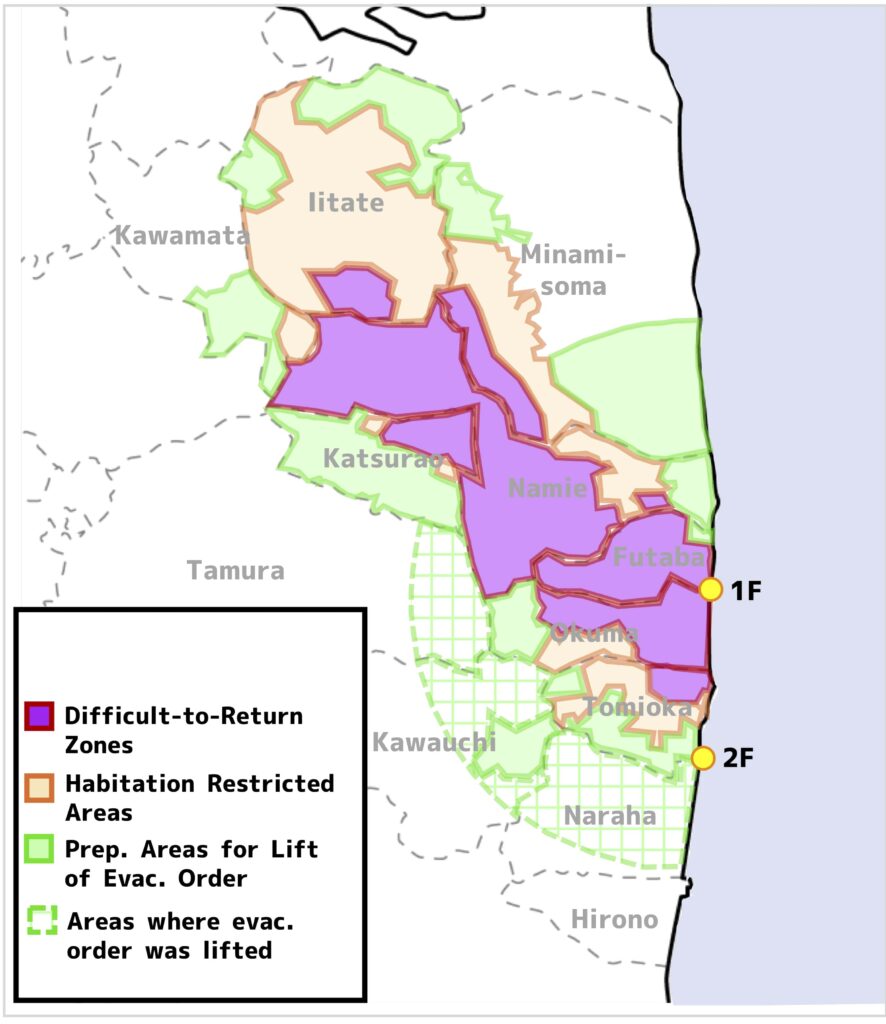
↑September 5, 2015
June 12, 2016
In June, 2016, evacuation orders in both the Habitation Restricted Areas and the Preparation Areas for Lift of Evacuation Order in Katsurao Village were lifted.
In the case of Kawauchi Village, the Habitation Restricted Areas was re-categorized into the Preparation Areas for Lift of Evacuation Order, but in the case of Katsurao Village, evacuation order of the Habitation Restricted Areas was lifted on that day.
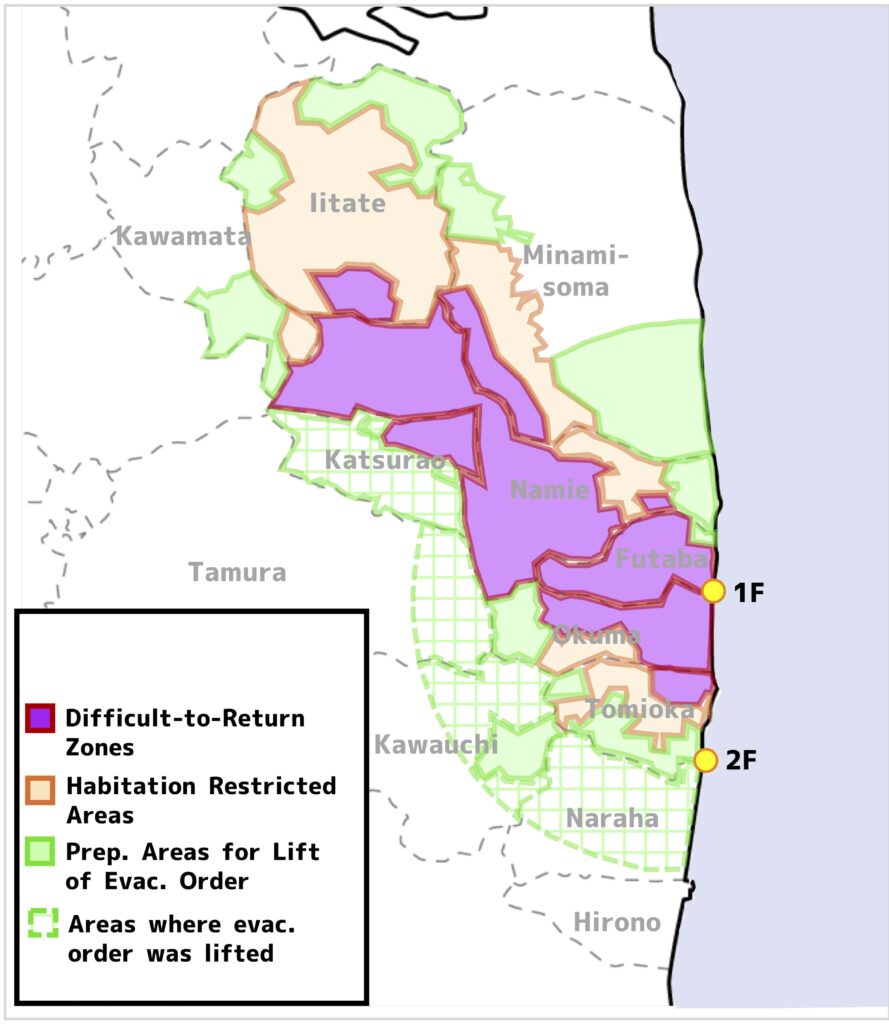
↑June 12, 2016
June 14, 2016
2 days later, evacuation order in Kawauchi Village was lifted.
Kawauchi Village is the third municipality, where evacuation order for whole municipality was lifted.
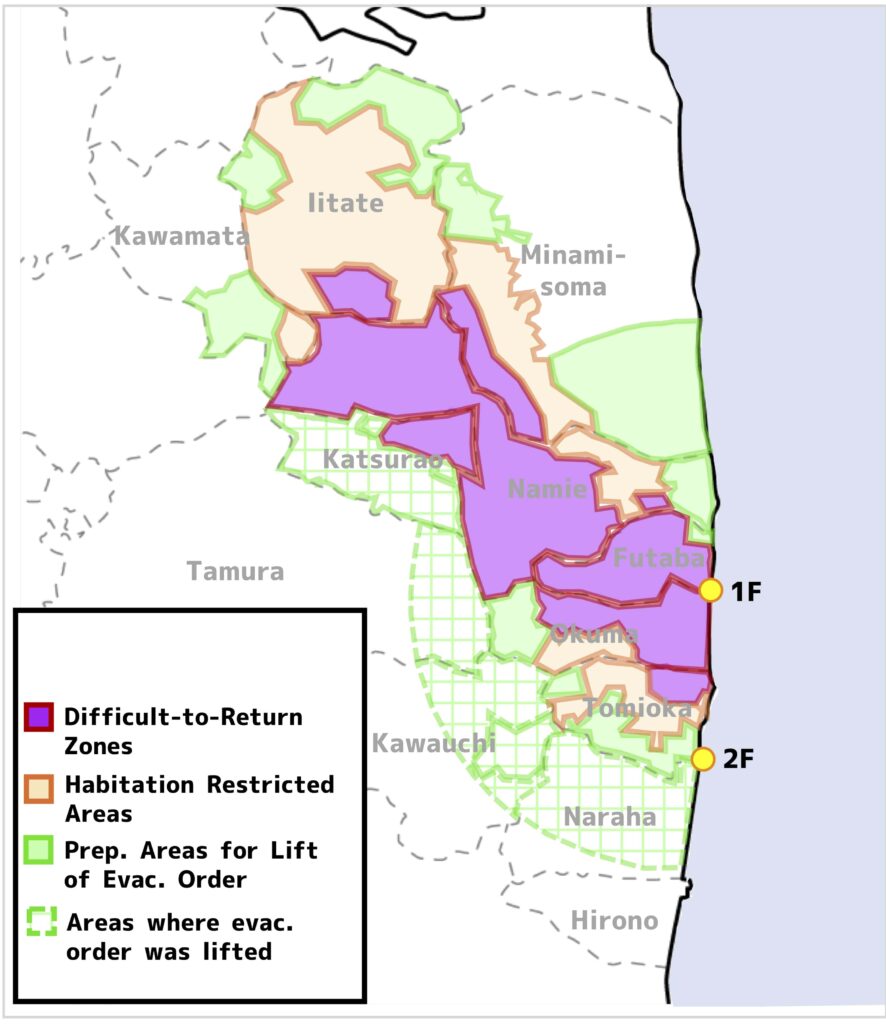
↑June 14, 2016
July 12, 2016
Further to that, in the next month, evacuation orders in the Habitation Restricted Areas as well as the Preparation Areas for Lift of Evacuation Order were lifted in Minamisoma City.
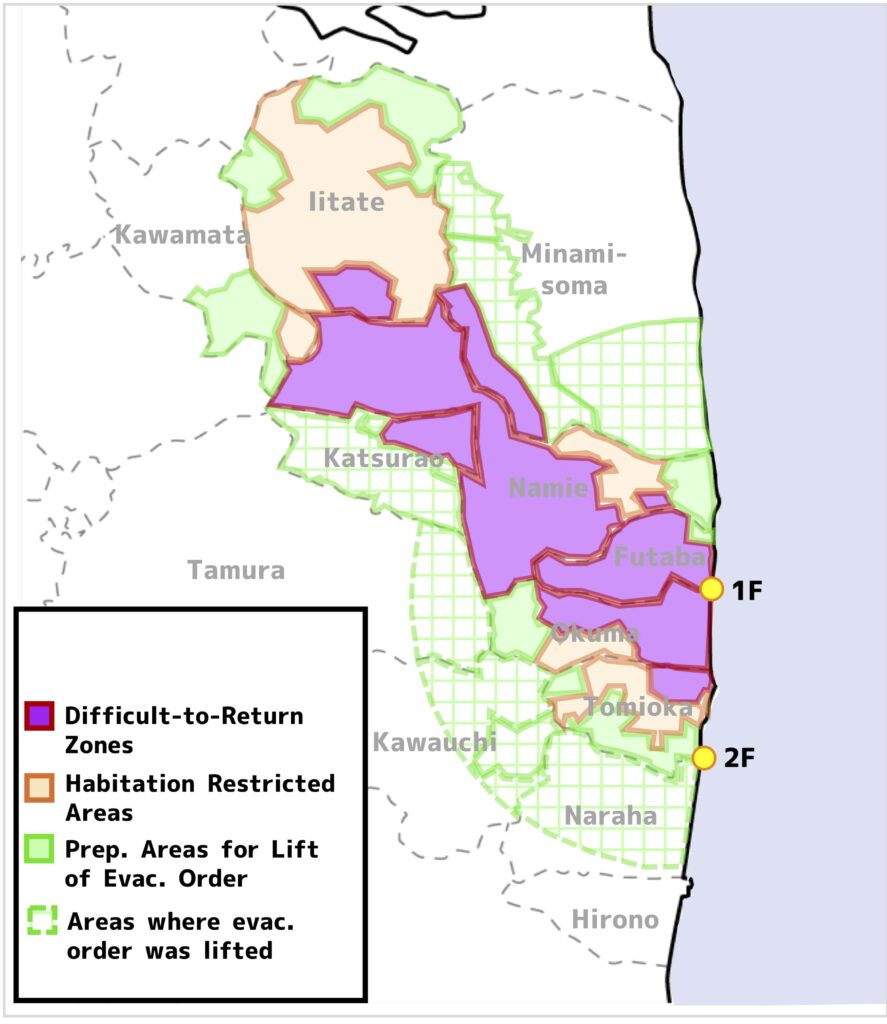
↑July 12, 2016
March 31, 2017
Moreover, at the end of March of the next year, evacuation orders in both the Habitation Restriction Areas and the Preparation Areas for Lift of Evacuation Order in Iitate Village, Kawamata Town as well as Namie Town were lifted.
Kawamata Town is the fourth municipality, where evacuation order for whole municipality was lifted.
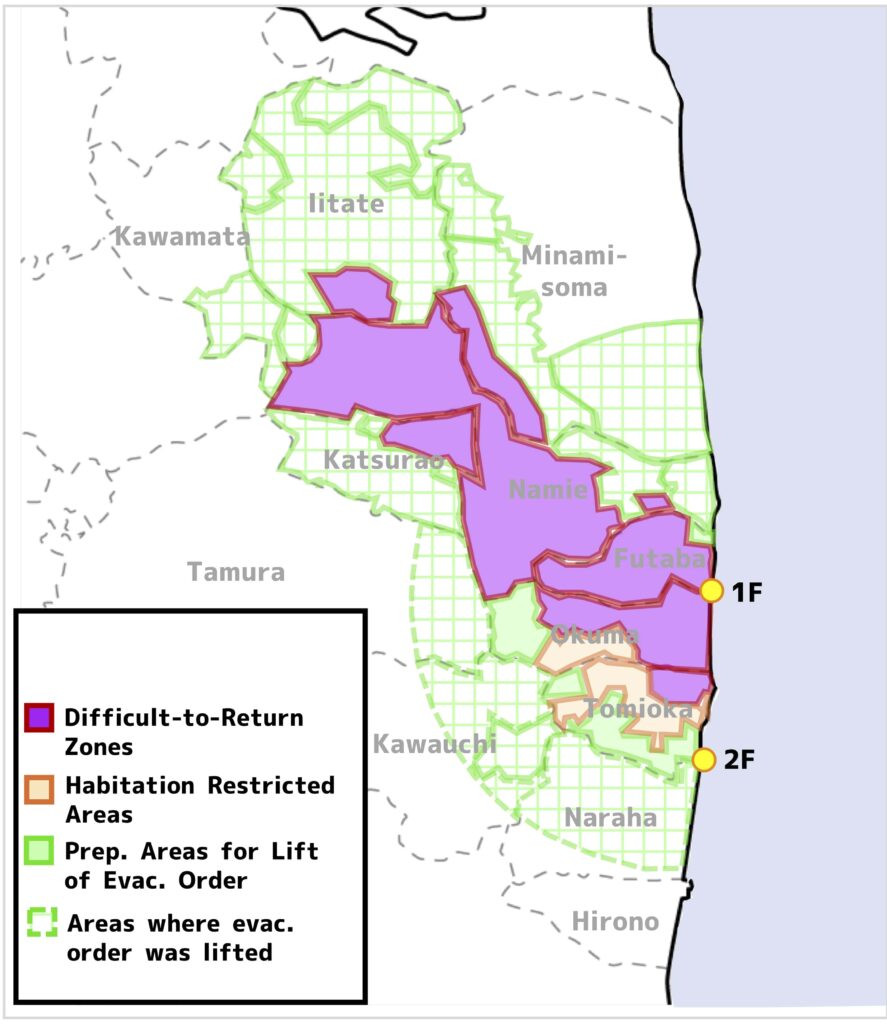
↑March 31, 2017
April 1, 2017
On the next day, evacuation orders in the Habitation Restricted Areas and the Preparation Areas for Lift of Evacuation were lifted in Tomioka Town.
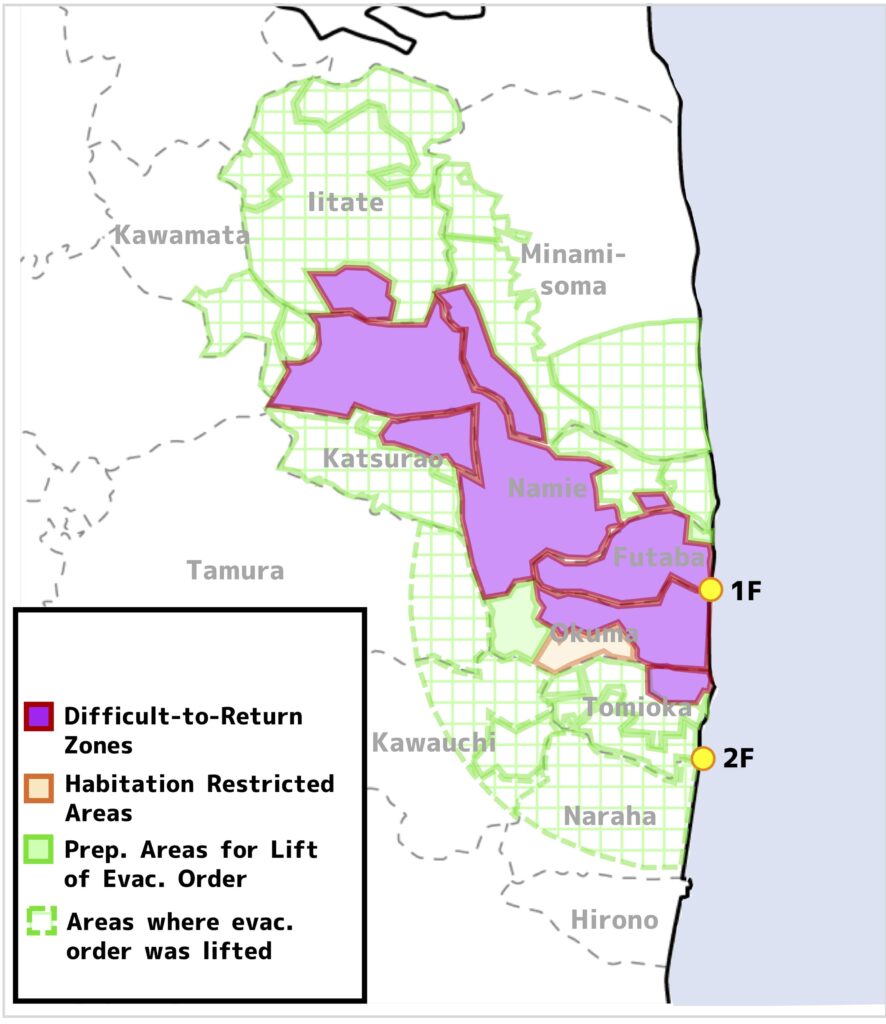
↑April 1, 2017
April 10, 2019
Around 2 years later, evacuation orders in the Habitation Restricted Areas and the Preparation Areas for Lift of Evacuation were lifted in Okuma Town.
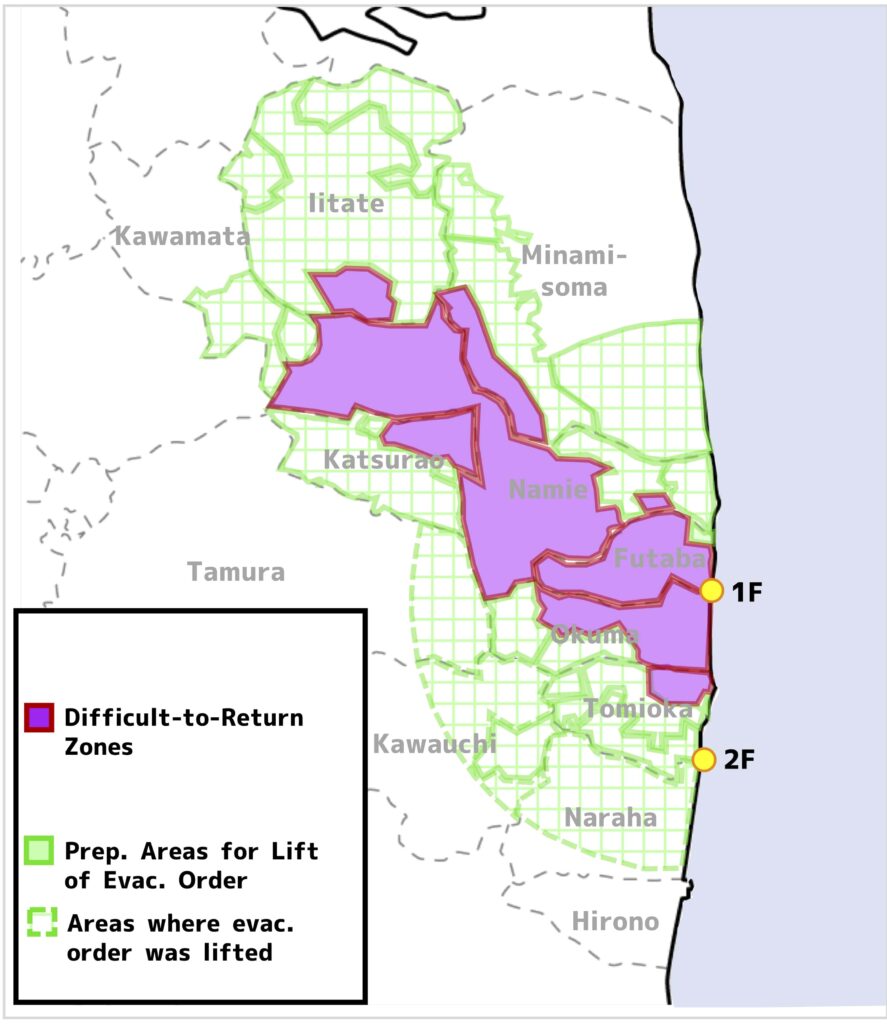
↑April 10, 2019
March 10, 2020
After around one more year had passed, in March 2020, the Preparation Areas for Lift of Evacuation Order was lifted in Futaba Town.
Then all of the evacuation orders, other than the Difficult-to-Return Zones, were lifted after 9 years passed after the accident.
Further to that, by March 10, in collaboration with full re-open of the JR Joban Railway, evacuation orders for the stations and surrounding roads, in Okuma Town, Futaba Town as well as Tomioka Town in the Difficult-to-Return Zones were lifted.

↑March 10, 2020
Summary
This article covers evacuation areas after the accident of the Fukushima Daiichi Nuclear Power Plant, especially focusing on the difference of the evacuation areas after re-organization, conditions for lift of evacuation orders and changes over time from the beginning of lift of evacuation orders (January 2014) to lift of all evacuation orders other than the Difficult-to-Return Zones (March 2020).
By the way, above-mentioned contents are summarized in the following videos.
It would be appreciated to visit them at your convenience.
– Japanese version
– English version
You can read the same article in Japanese here.
Thank you very much for reading this article.
See you next time!



コメント